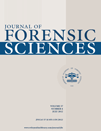Fatal Paradoxical Air Embolism Diagnosed by Postmortem Imaging and Autopsy
Abstract
Abstract: The recognition and visualization of an arterial gas embolism are difficult. We report a case of sudden death caused by paradoxical air embolism of coronary and cerebral arteries, diagnosed by the pre autopsy computed tomography (CT) scanning. A 54-year-old woman suddenly died after the self-removal of the jugular vein catheter. Postmortem imaging examination using CT scanning showed multiple gas embolisms in the cerebral arteries, pulmonary artery, right atrium and ventricle, left ventricle, aorta, and coronary arteries. These findings suggested that the occurrence of acute ischemia of the brain and heart caused by massive air inflow to the artery. Conventional autopsy revealed a patent foramen ovale of the heart. These results indicated that the patient died of paradoxical air embolization of the coronary and cerebral arteries through a patent foramen ovale because of right-to-left shunting. The use of postmortem imaging as an aid for conventional autopsy has proved to be of advantage in the case of gas embolism.




